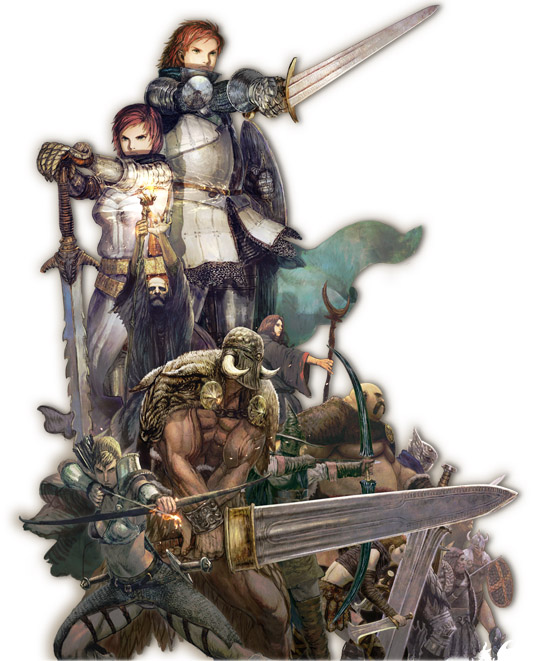Dragon's Dogma: Characters, Part 3

Now that we have a solid grasp of magic in the world of Dragon’s Dogma, we can finish our tour of its vocations and how they relate to the templates in GURPS Dungeon Fantasy. The last big category we have yet to cover are Hybrid Vocations, which I think are one of the most distinctive aspects of the original game.
Hybrid Vocations in Dragon’s Dogma
Dragon’s Dogma has three hybrid vocations, each of which combines aspects from two of the color-coded categories we covered back in Part 1. They are covered here in a little more detail than the single-color vocations were, because I feel it’s important to examine how their concepts are executed.
The Red/Yellow vocation is the Assassin. An Assassin can equip all basic “red” and “yellow” weapons in any combination, which allows them to have a large number of active special abilities accessible via the equipment menu. These abilities tend to have involve high mobility and precision damage, with some use of explosives. An Assassin is versatile and fights by choosing the best weapon for each opponent and trying to kill them quickly before they can fight back.
The Yellow/Blue vocation is the Magic Archer. They can wear heavier armor than a pure spellcaster, and since their arrows are made of magic they use no ammunition. Their abilities add specific elemental and “trick” effects to their arrows (bouncing on walls, explosions, and so on). They fight mostly by remaining at range and hitting enemies on their elemental vulnerabilities.
The Red/Blue vocation is the Mystic Knight. Mystic Knights wear heavy armor and wield one-handed swords or maces paired with large shields. Their abilities allow them to reflect blocked damage back to the attacker, add elemental damage to the whole party’s weapons at once, and place damaging mystical sigils on the ground. They fight by controlling the battlefield and making sure the enemy suffers for any decision they make.
Missing Templates
You might have been wondering how the two DF 1 templates we haven’t discussed yet fit into this. The short answer is they don’t.
Martial Artists would seem like a good example of a Yellow/Blue template, as they rely on agility and have access to supernatural powers. However, the template as it stands is tied into the whole “kung-fu” aesthetic, which Dragon’s Dogma doesn’t really go for. The “exotic but supremely skilled foreign combatant” niche is better filled by a Swashbuckler wielding fencing weapons.
Holy Warriors also seem like a good example of a Red/Blue template, but once again the Holy Might power implies a strong connection to the divine that doesn’t match the way magic works in this setting. Changing this template to match Dragon’s Dogma magic would be more work than it was for the Cleric, and so it’s better to drop it.
Hybrid Templates
How can we translate the feel of these vocations into Dungeon Fantasy templates? The obvious way would be to resort to the Mixed Profession lenses from GURPS Dungeon Fantasy 3: The Next Level. Aside from giving players the ability to combine powers from multiple templates, they also feel like an “advanced option” for characters with a some experience under their belts, just like their counterparts in the original game.
The other option would be to create a character from the start using a template that draws on multiple concepts to inform their abilities. We will also look at those options here.
A good way to get a versatile, “Assassin”-like character is to add a Scout lens to a character who started with either the Knight or Swashbuckler template. Alternatively, you can add the Swashbuckler lens to a Scout, choosing a melee weapon such as a broadsword. This will leave you with an agile character who is equally adept at ranged and melee combat. A small investment in the appropriate Fast-Draw specialties and the Quick-Sheathe perk can ensure you always have the right weapon on hand.
For a “Magic Archer”-like character, adding the Scout lens to a spellcaster certainly helps, but the most important bit is the Spell-Archery spell found in both DF 3 and DF 11. Doing it the other way around (Adding a Wizard lens to a Scout) is somewhat less efficient but still possible.
Similarly, a “Mystic Knight”-like character could be approximated by either a Knight with the Wizard lens or a Wizard with the Knight lens. A Cleric with the Knight or Swashbuckler lens would also work and give us a more balanced approach.
In both cases, the choices available feel somewhat unsatisfactory, as the end result doesn’t strike a good enough balance between the physical and magical sides of the concept.
As an aside, I’m aware that there’s a Mystic Knight template in Pyramid #3/13. Despite the rather fortuitous naming coincidence, I chose not to include it because it uses Imbuements. While I like the concept of Imbuements, I don’t like the amount of rolls their implementation adds to the average fight.
New Templates!
So it seems we have two vacancies in our template lineup with the removal of the Holy Warrior and Martial Artist. Given that the “Mixed Professions” route for creating a Magic Archer or a Mystic Knight leaves something to be desired, I feel compelled to bring the number of available templates back to 11 by creating two entirely new templates for those vocations. This will be the subject of my next couple of posts.